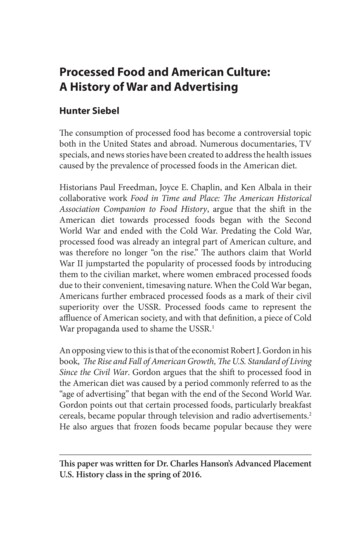
Transcription
Processed Food and American Culture:A History of War and AdvertisingHunter SiebelThe consumption of processed food has become a controversial topicboth in the United States and abroad. Numerous documentaries, TVspecials, and news stories have been created to address the health issuescaused by the prevalence of processed foods in the American diet.Historians Paul Freedman, Joyce E. Chaplin, and Ken Albala in theircollaborative work Food in Time and Place: The American HistoricalAssociation Companion to Food History, argue that the shift in theAmerican diet towards processed foods began with the SecondWorld War and ended with the Cold War. Predating the Cold War,processed food was already an integral part of American culture, andwas therefore no longer “on the rise.” The authors claim that WorldWar II jumpstarted the popularity of processed foods by introducingthem to the civilian market, where women embraced processed foodsdue to their convenient, timesaving nature. When the Cold War began,Americans further embraced processed foods as a mark of their civilsuperiority over the USSR. Processed foods came to represent theaffluence of American society, and with that definition, a piece of ColdWar propaganda used to shame the USSR.1An opposing view to this is that of the economist Robert J. Gordon in hisbook, The Rise and Fall of American Growth, The U.S. Standard of LivingSince the Civil War. Gordon argues that the shift to processed food inthe American diet was caused by a period commonly referred to as the“age of advertising” that began with the end of the Second World War.Gordon points out that certain processed foods, particularly breakfastcereals, became popular through television and radio advertisements.2He also argues that frozen foods became popular because they wereThis paper was written for Dr. Charles Hanson’s Advanced PlacementU.S. History class in the spring of 2016.
50Hunter Siebelmarketed to the American public offering the possibility of a “utopian”future: a world where women didn’t need to cook, where the cost ofliving was low, and where ample food existed in every household.3Gordon argues that the most important shift in food marketing wasthe self-serve supermarket. These supermarkets offered a new level ofconvenience to the consumer, therefore becoming extremely popular,and paved the way for the further rise of processed foods.4Many historians disagree about the origin of processed food’sprominent role in modern society. Answers to this question includeadvertising, Cold War politics, technological advances in industry,World War II, and even women’s rights. While all of these serve asvalid parts of the answer, the important question is which factors hadthe greatest impact. Although advertising can be pinpointed as themost important factor in the shift in the American diet to processedfoods between 1940 and 1960, the success of this national advertisingcampaign could not have been attained without the pre-establishedculture of processed food caused by World War II. Indeed, the SecondWorld War popularized processed food by making it easily accessibleto consumers both during and after the war, as well as making thepurchcase of processed foods a symbol of patriotism.The American IllusionPost-World War II advertising can be deemed the primary cause ofthe shift from fresh to processed food because it associated processedfood with an ideal, desirable lifestyle.By 1955, nearly 65 percent ofAmerican homes had a television.5 TV shows such as “Leave it toBeaver” and “Father Knows Best” portrayed the perfect suburbanAmerican family. These families shopped at grocery stores and thepresentable mother character had stereotypical female duties, such ascooking nightly family meals, doing house chores, and being attentiveto her children. These TV families came to symbolize the ideal familythat every American strived to match.6Processed food was marketed as a shortcut to becoming one of theseideal American homemakers. An example of this is the television ad
THE MENLO ROUNDTABLE51for Pillsbury’s instant mashed potatoes and cakes. It was marketedas a “woman’s secret” to provide easy food that tasted so much likehomemade potatoes, even your husband wouldn’t recognize thedifference, all while allowing mom to “swish into dinner un-steamed,serene.”7 Processed food, like these instant potatoes, was marketedwith the promise of creating the stereotypical lifestyle found on TVand in other media. Similarly, a 1956 magazine ad for sliced bread wasmarketed with the slogan, “We do you should too!” in which a typicalAmerican housewife and her children were pictured flashing big whitesmiles and enjoying their slices of bread with jam (see Appendix A).8 Inthis ad, it wasn’t just the food being marketed to the American people—it was the storybook family that came with it. Processed foods werehighly valued for their convenience and became increasingly popularwhen those aspects were marketed because they allowed women toappear as the same diligent homemaker they were before the SecondWorld War, when, in reality, many women were trying to expand theirhorizons out of the home.Many women were in need of faster, more convenient ways to remainthe ideal housewife in the eyes of society because, even after theirhusbands returned at the end of the war, many women wanted tocontinue working or participate in other activities beyond housework.The war put many women into factory jobs that disappeared with thereturn home of the World War II veterans. Published in 1946 afterWorld War II, an article entitled, How Come No Jobs for Women?describes the desire of women to work after the war for both personaland economic reasons.9 The problem was that there wasn’t time to beboth a worker and the perfect American housewife.10 Processed foodwas advertised to the American women as the loophole that allowedfor both, which is why the campaigns worked so effectively, makingprocessed foods a popular commodity in nearly every American home.While direct advertising to American women affected the popularityof processed foods as a means to achieve the lifestyle they desired,indirect advertising also associated processed food with a message ofcivil superiority, a message that Americans were determined to conveyduring the Cold War. In the kitchen debate of 1959, Vice President
52Hunter SiebelRichard Nixon toured the American National Exhibition in Moscowwith Soviet Premier Nikita Khrushchev. The American Exhibitiontook place at the height of the Cold War and was used to informRussians about American capitalism. In order to do this, the U.S. StateDepartment asked General Mills, General Foods, Pepsi-Cola, and otherprocessed food companies to participate. General Mills and GeneralFoods alone shipped seven tons of food including cake and browniemixes, packaged cereals, and other processed foods to the exhibition.11While flaunting the abundance of processed food in the kitchensection of the exhibition, Vice President Nixon told Khrushchev, “theAmerican system is designed to take advantage of new inventions andnew techniques,” implicitly associating the superiority of capitalismover communism with the advanced technologies being used in theAmerican processed foods on display.12 Thousands of Americanswatched Nixon make this parallel from their screens at home, andsoon, Nixon’s association came to be that of the whole of Americansociety. In the eyes of Americans, “processed foods became ametaphor for the political, economic, and cultural supremacy of theUnited States.”13 Additionally, the Space Race was also happening in1959, a period when Americans were attempting to technologicallyoutdo communist Russia by being the first country to dominate outerspace. Processed foods became extremely popular because they werepresented to the American people as a badge of supremacy in a timewhere Americans were desperate to cling to any evidence that theirsociety was more advanced than the USSR’s.Patriotic FoodThe Second World War was a cause in the shift from fresh food toprocessed food because the United States government produced anddistributed many pieces of war propaganda insinuating that eatingand producing processed food was patriotic. Many posters like thepropaganda piece entitled Can All You Can: It’s a Real War Job! fromthe Office of War Information in 1943 encouraged people, particularlywomen, to can foods at home for use during the winter because ofrationing and insinuated that participating in food processing waspatriotic, because it helped with the war effort (see Appendix B).14
THE MENLO ROUNDTABLE53The significance of this type of propaganda is that it demonstrateshow home canning became a patriotic obligation for Americans onthe home front therefore making Americans accustomed to processedfood and eventually making canned foods an important staple in theAmerican diet.In a Magazine War Guide produced and distributed by the Office ofWar Information (OWI) in 1945, a list was provided of publicationsthat could be ordered from the OWI that taught techniques of foodpreservation.15 The publications include Oven Drying, Home Canningof Meat, Preservation of Vegetables by Salting or Brining, and more.16This publication about home canning and food preservation shows howthe U.S. government pressured Americans to participate in and acceptfood processing during World War II. The government’s push to makefood processing commonplace in every American household meantthat after the war, when home canning was no longer a nationalisticduty, Americans readily purchased factory-made processed foodbecause they had already been consuming and producing similarproducts in their own kitchens.Another call to Americans’ patriotic duty to the war effort came fromnutrition. However, little was actually known about nutrition duringthe war or in the proximate years to follow. For example, the U.S. WarFood Administration (WFA) distributed a piece of propaganda entitledEat the Basic 7. Every Day! Eat a Lunch That Packs a Punch! in 1943implying that certain foods were of equal nutritional value whetherraw, dried, frozen, evaporated, or canned (see Appendix C).17 Theposter states that Americans should “eat a lunch that packs a punch every day,” comprised of the seven food groups in order to be the“strong” citizens that the country “needs.”18 In the subtext of each foodgroup, the poster lists processed varieties of the original food that canbe eaten as an equally beneficial substitute. Because processed foodwas often more accessible to consumers during the Second World War,and was deemed nutritionally equivalent to fresh food, it was oftensubstituted for fresh. Therefore, being encouraged by patriotism toeat a product from each food group every day usually meant eating amajority of processed products over fresh to fill one’s daily quota.
54Hunter SiebelThe U.S. government asked the American people to buy processedfood during the war in order to maintain low war costs and keep theeconomy in check. The Price Control Act of 1942 was passed in orderto keep factory wages low and avoid a slow down of the industrialwork necessary to the war effort.19 A pamphlet published by thePrice Administration Office in 1942 states, “when prices go sky high,everyone suffers,” and that in order to fulfill one’s patriotic duty tokeep prices low, one should buy items under price controls.20 Yet theonly foods placed under price controls were processed: evaporatedand condensed milk, corn meal, dried beans and onions, fresh andcanned fruit juice, while fresh fruits and vegetables were not.21 TheUnited States government convinced the American people that buyingprocessed food meant being patriotic, associating the model citizenwith someone who avoided fresh and chose processed instead. Withthis association, Americans increased the amount of processed foodthey bought in supermarkets; further popularizing processed food andmaking it an integral part of America’s food culture.War is a MidwifeThe Second World War made processed food popular because itsupported processed food companies during the war, encouragingthe mass production of processed food. By 1943 there were nearly 11million men enlisted in the army, 7 million more than the previousyear, fighting in various regions of the world.22 Not only was theU.S. government responsible for feeding these men, but also due toFDR’s Lend-Lease policy, nearly ten percent of the United States’ totalfood production output was being shipped to the allied forces.23 Outof this necessity to provide, the processed food industry was born.Unable to send fresh meat, fruit, and vegetables that would spoil whilebeing transported, the U.S. government looked to canning, freezing,powdering and other processing methods that allowed food to haveprolonged shelf life and be easily packaged for shipping purposes. Outof this sudden interest food processing for the war effort came manyscientific industrial developments and still well-known today productssuch as T.V. dinners, sliced bread, enriched white flour, fruit juice,instant coffee and hot chocolate, M & M’s, and more.
THE MENLO ROUNDTABLE55Government-set rationing point rules swayed Americans towardsprocessed food because it made processed items more easily attainablethan other products. Processed foods were added to the list of rationeditems in March of 1942 along with meat, cheese, canned milk, andother goods.24 On average, during the war processed foods requiredfewer rationing points than fresh food like meat and cheese, makingprocessed foods popular as meatless meal alternatives. For example,50 million boxes of Kraft macaroni and cheese were purchased in 1943because two boxes could be purchased with only one rationing stamp.Although fresh fruits and vegetables were not rationed, supplies werelimited unless you had your own victory garden, and even then mosthomegrown items were processed in the home by canning and otherpreservation methods for prolonged use.The Second World War played a key role in the popularizationof processed foods in the post-war era because it allowed foodprocessing companies the means to mass distribute food to the civilianmarket. When the Second World War came to an end, so did the U.S.government’s need for processed food. Food processing companiesused to producing at high levels were suddenly left with half of theirprevious product demand. But instead of operating at fifty percentcapacity, companies adjusted, shifting all of their focus to the civilianmarket, where many of their products were already popular, but hadbeen in limited supply due to the needs of the war.25 With productavailability no longer a concern, processed foods flew onto grocerystore shelves and then into American homes.An article entitled Food Men Discuss 4,000,000,000 Year, published in1950, explains that food production companies were beginning to hirefood brokers “to secure distribution for their products.”26 Companies’use of food brokers brought more processed foods than ever beforeto the consumer market. Because many of the processed foods werealready in high consumer demand, their sudden abundance in themarket, which was made possible by continuation of Second WorldWar production levels, allowed Americans to consume more processeditems at a low cost. This only furthered the popularity of processedfood and its association with the American identity.
56Hunter SiebelWhereas certain products had been subject to limited availabilityduring the war, processed food companies were able to easily capitalizeon the civilian market by redirecting their already high productionoutput to the consumers. In a letter from Charles Bowles, a priceadministrator at the Office of Price Administration (OPA), to theeditor of The New York Times in 1944, Bowles expresses his concern forthe post war economy.27 Bowles’ biggest concern was the inflation thatwould occur when consumers demand products for which “suppliesfor a considerable period will be running far behind.”28 Because of thewar, there were few factories producing consumer goods—many hadbeen modified to produce airplanes and other war materials instead.However, there was one product that met the constraints of both highdemand and high abundance: processed food. Government supportof processed food production during the Second World War gaveprocessed food companies the ability to capitalize on a pre-disposedconsumer market in the post-war era. For years, consumers hadendured limited supplies of processed products, and with the end ofthe war, processed food companies no longer had to meet governmentallocations and could put their energies into mass consumerdistribution. Suddenly, processed food was abundantly available inevery supermarket across America.Food is FashionAdvertising and the Second World War greatly impacted thepopularization of processed food in American society. And yet theSecond World War and advertising are only two of the many causesfor the shift to processed food in the American diet. Other big factorslike technological developments in food processing between 1940 and1960, such as the microwave oven, are beyond the scope of this paper.I chose to focus on the War and advertising because in my research,most of my evidence pointed to these factors as the primary causes forthe shift to processed food.
THE MENLO ROUNDTABLE57The shift in the American diet to processed foods, dating back to 1940,is now beginning to show its adverse affects. Because of this shift,obesity and other health concerns plague our nation. Even though welive in a world today where butter and fortified margarine are not theirown food group, and processed food no longer symbolizes the affluenceand success of America, our society is still struggling to break its old,unhealthy habits.Understanding the history of why we eat the way we do is a key factorin understanding how we can change those unhealthy habits. For years,people have been arguing that society should stop eating processedfood because it’s unhealthy, but we have seen minimal changes in theAmerican diet as a result. But by looking at history, we can understandthat eating food is about a lifestyle, not about the quality of the product.In order to see real results in American eating patterns, we have tomake fresh fashionable.Luckily, this is beginning to take place in American society, withsocial media at the forefront. Social media is serving as an advertisingmedium for the healthy lifestyles of many people and is beginning tomake being healthy the contemporary choice in mainstream society.This is the first step to fixing America’s processed food epidemic.
58Hunter SiebelAppendix AA&P Jane Parker Bread. Magazine advertisement. 1956.
THE MENLO ROUNDTABLEAppendix BOffice of War Information. “Can All You Can: It’s a Real War Job!”Illustration. 1943. World War II Poster Collection. NorthwesternUniversity Library.59
60Hunter SiebelAppendix CWar Food Administration. “Eat the Basic 7. Every Day! Eat aLunch That Packs a Punch!” Illustration. 1943. UNT Digital Library.University of North Texas.
THE MENLO ROUNDTABLENotes1. Paul Freedman, Joyce E. Chaplin and Ken Albala, Food in Timeand Place: The American Historical Association Companion to FoodHistory (Berkeley: University of California Press, 2008), 171-172.2. Robert J. Gordon, The Rise and Fall of American Growth:The U.S. Standard of Living Since the Civil War (Princeton NJ:Princeton University Press, 2016), 351.3. Ibid.4. Ibid., 352.5. “Number of TV Households in America,” chart, 1980,Television History.6. Sherri Machlin, American Food by the Decades(Santa Barbara: ABC- CLIO, 2011), xv.7. Pillsbury Instant Mashed Potatoes, television advertisement(1954; Durham NC: Duke University Libraries).8. A&P Jane Parker Bread, magazine advertisement (1956).9. Margaret Barnard Pickel, “How Come No Jobs for Women?,”New York Times, January 27, 1946.10. Norma Yerger Queen to Office of War Information, 1944.11. Monte Olmsted, “Nixon, Khrushchev, and Betty Crocker at the1959 ‘Kitchen Debate,’” Taste of General Mills (blog), July 24, 2014.12. Richard Nixon and Nikita Khrushchev, “The Kitchen Debate,”July 24, 1959, transcript, Teaching American History.13. Freedman, Food in Time and Place, 172.61
62Hunter Siebel14. Office of War Information, “Can All You Can: It’s a Real War Job!,”illustration, 1943, World War II Poster Collection, NorthwesternUniversity Library.15. Magazine War Guide (Washington D.C.:Office of War Information, 1945), 10.16. Ibid.17. War Food Administration, “Eat the Basic 7. Every Day! Eat aLunch That Packs a Punch!,” illustration, 1943, University of NorthTexas Digital Library.18. Ibid.19. Roosevelt to Congress, “Message to Congress on theFood Program.”20. How You Can Help Keep Wartime Prices Down!(Washington D.C.: Price Administration Office, 1942),1; Ibid., 17.21. Ibid., 16.22. Franklin D. Roosevelt to Congress, “Message to Congress onthe Food Program,” November 1, 1943, The American PresidencyProject, University of California, Santa Barbra.23. Ibid.24. Robert Higgs, “The Two Price System,” The Freeman, April 24, 2009.25. “Grocery Retailers’ Head Calls For Removal of Price Controls,”New York Times, February 4, 1946.26. “Food Men Discuss 4,000,000,000 Year,” New York Times,January 25, 1950.27. Chester Bowles to the editor of the New York Times, June 18, 1944.28. Ibid.
THE MENLO ROUNDTABLE63BibliographyPrimary SourcesA&P Jane Parker Bread. Magazine advertisement. 1956.Bowles, Chester. Chester Bowles to the editor of the New York Times,New York, June 18, 1944.How You Can Help Keep Wartime Prices Down! Washington D.C.:Price Administration Office, 1942.Magazine War Guide. Washington D.C.: Office ofWar Information, 1945.New York Times. “Food Men Discuss 4,000,000,000 Year.”January 25, 1950.New York Times. “Grocery Retailers’ Head Calls for Removal of PriceControls.” February 4, 1946.Nixon, Richard. Richard Nixon and Nikita Khrushchev, “The KitchenDebate.” Transcript. July 24, 1959. Teaching American History.Office of War Information. “Can All You Can: It’s a Real War Job!”Illustration. 1943. World War II Poster Collection. NorthwesternUniversity Library.Pickel, Margaret Barnard. “How Come No Jobs for Women?”New York Times. January 27, 1946.Pillsbury Instant Mashed Potatoes. Television advertisement.Durham: Duke University Libraries, 1954.Queen, Nancy Yerger. Nancy Yerger Queen to Office of WarInformation, UT, 1944.
64Hunter SiebelRoosevelt, Franklin D. Franklin D. Roosevelt to Congress, “Messageto Congress on the Food Program,” November 1, 1943. The AmericanPresidency Project. University of California, Santa Barbara.War Food Administration. “Eat the Basic 7. Every Day! Eat aLunch That Packs a Punch!” Illustration. 1943. UNT Digital Library.University of North Texas.Secondary SourcesFreedman, Paul, Joyce E. Chaplin, Ken Albala. Food in Time andPlace: The American Historical Association Companion to FoodHistory. Berkeley: University of California Press, 2014.Gordon, Robert J. The Rise and Fall of American Growth: The U.S.Standard of Living Since the Civil War. Princeton NJ: PrincetonUniversity Press, 2016.Higgs, Robert. “The Two Price System.” The Freeman, April 28, 2009.Machlin, Sherri. American Food by the Decades. Santa Barbara:ABC- CLIO, 2011.“Number of TV Households in America.” Chart (1980):Television History.Olmsted, Monte. “Nixon, Khrushchev, and Betty Crocker at the 1959‘Kitchen Debate.’” Taste of General Mills (blog). July 24, 2014.
The consumption of processed food has become a controversial topic both in the United States and abroad. Numerous documentaries, TV specials, and news stories have been created to address the health issues caused by the prevalence of processed foods in the American diet. Historians Paul










